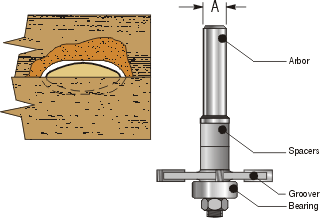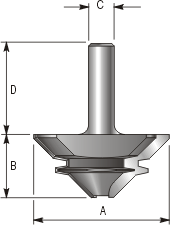All the biscuit cutters I've seen for routers are around 20-30mm* radius.
This is a lot less than the main curves on biscuits, which are intended to match the dedicated machine's cutter, at around 4" (say 50mm radius).
The original Lamello handheld design was based on a
small disc grinder and they still are. You couldn't easily use a router with a cutter of that size. I believe grinders gain mechanical torque advantage through the right-angle gearbox (crown wheel probably), but most routers would stall as they couldn't deliver the necessary torque.
That leaves a problem, shown in Wealden's diagram:
The biscuits only fit the slot's thickness, not its depth nor width. It's both good news and bad news really - the slot can be shorter than the one made by a proper jointer, so theoretically you can set up the joint with almost no sideways slip in it, but the joint is also slightly weaker (in end grain), as there is less support for the glue surfaces towards the ends of the biscuit.
You also can't make biscuit slots in the midle of a board, because the router physically won't fit.
I have two router biscuit cutters: an expensive Trend one with swappable bearings and an el-cheapo, one-size Screwfix one that came with a router bought on eBay. Both are "deficient" in that you have to waggle the stock slightly to get the correct shape. This inevitably leads to a bit of slot thickness widening too. Addressing the stock to the cutter, rather than the other way round (with a proper jointer), is the biggest single reason for sloppy joints in my experience.
I've recently had a big shelf split (made of pine staves). It was made some years ago, and being the top of a boxing-in in the bathroom, it's suffered serious humidity changes. The biscuited joints have failed, and I think the main reason is that they were done on the router table, before I bought my jointer.
There was a _very_ slight wind to the wood, which would have had a negligible effect on the jointer, but caused a bit of wobble on the flat router table, and widened the slots, so that the biscuits didn't grip well enough. OK, I should have squared it first, I know, but you live and learn, and at the time I didn't have the tools to do that easily.
I used the router table for a number of years before buying a proper Makita joiner. I don't regret changing over one bit. The joints are much stronger, mainly because the thickness is better controlled. Setup is much faster and easier, it's less messy and more useful (for most small jobs the dust bag is good enough).
IMHO, it's also safer too. I watched with horror one 'expert" on YouTube ("Jimmy's jig" or something) showing how you can forget a whirling cutter and almost lose a thumb. Router cutters leave nothing that can be stuck back on, no matter how good the surgeon.
The 4mm cutters on the router table are nice grooving/slotting cutters though, as the relatively large radius gives a nice finish compared to using a small cutter vertically (and the RPM can be a lot lower, and you can take one pass to depth usually as long as you feed at the right speed). Beyond that I don't think there's any point, and I'd
always reach for the jointer instead.
E.
*Wealden do a "heavy-duty" 4mm cutter that's 60mm diameter (on an 8mm shank). It's not cheap though. They don't class it as a biscuit cutter, either, although I'm not sure why.







